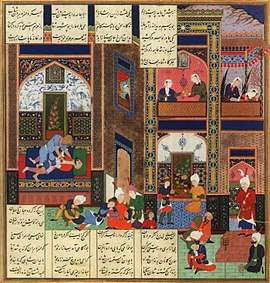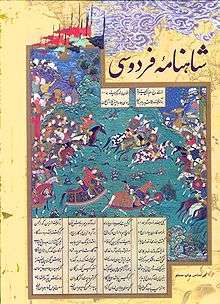Fall of the Sasanian Empire
The Sasanian era is one of the most influential periods in Persian Empire/Iran's history. It also marks the third rise of a great Persian empire, a dynasty that rivaled its predecessor, the Achaemenids, who too, like the Sassanids, were native to the province of Pars, and in some instances the Parthians, in glory and power. Although it fought many campaigns against the Romans/Byzantines in the west and the nomadic people in the east and north, the Sasanian Empire met its demise not by the Byzantine-Roman Empire, but by emerging Arab Muslims from across its southern borders.[1][2][3] However, the conflict with the Byzantines greatly contributed to its weakness, by draining Sassanid resources, leaving it a prime target for the Muslims.


Plague of Sheroe
The Plague of Sheroe was one of several epidemics that occurred in or close to Iran within two centuries after the first epidemic was brought by the Sasanian armies from its campaigns in Constantinople, Syria, and Armenia.[4] It contributed to the fall of the Sasanian Empire.
Social problems

Sassanid society was divided into four classes: priests, warriors, secretaries, and commoners. The latter formed the bulk of the population, served as its sole tax base, and remained its poorest class.
At the climax of Khosrau II's ambitious Byzantine territory conquests in the Levant and much of Asia Minor, taxes rose dramatically, and most people could not pay. Years of Sassanid-Byzantine wars had ruined trade routes and industry, the population's main income sources. The existing Sassanid administrative structure proved inadequate when faced with the combined demands of a suddenly expanded empire, economy, and population.[5] Rapid turnover of rulers and increasing provincial landholder (dehqan) power further diminished the Sassanids. Over a period of fourteen years and twelve successive kings, the Sassanid Empire weakened considerably, and the power of the central authority passed into the hands of its generals. Even when a strong king emerged following a series of coups, the Sassanids never completely recovered.
Military

Years of warfare between the Sasanians and the Byzantines, as well as the strain of the Khazar invasion of Transcaucasia, had exhausted the army. No effective ruler followed Khosrau II, causing chaos in society and problems in the provincial administration, until Yazdegerd III rose to power. All these factors undermined the strength of the Persian army. Yazdegerd III was merely 8 years old when he came to the throne and, lacking experience, did not try to rebuild the army. The Sasanian Empire was highly decentralized, and was in fact a "confederation" with the Parthians, who themselves retained a high level of independence.[6] However, after the last Sasanian-Byzantine war, the Parthians wanted to withdraw from the confederation, and the Sasanians were thus ill-prepared and ill-equipped to mount an effective and cohesive defense against the Muslim armies.[7] Moreover, the powerful northern and eastern Parthian families, the Kust-i Khwarasan and Kust-i Adurbadagan, withdrew to their respective strongholds and made peace with the Arabs, refusing to fight alongside the Sasanians.
Pourshariati argues that the Arab conquest of Mesopotamia "took place, not, as has been conventionally believed, in the years 632–634, after the accession of the last Sasanian king Yazdgerd III (632–651) to power, but in the period from 628 to 632."[8] An important consequence of this change in timeline means that the Arab conquest started precisely when the Sasanians and Parthians were engaged in internecine warfare over who was to succeed the Sasanian throne.[8]
When Arab squadrons made their first raids into Sasanian territory, Yazdegerd III did not consider them a threat, and he refused to send an army to encounter the invaders. When the main Arab army reached the Persian borders, Yazdegerd III procrastinated in dispatching an army against the Arabs. Even Rostam-e Farokhzad, who was both Eran Spahbod and Viceroy, did not see the Arabs as a threat. Without opposition, the Arabs had time to consolidate and fortify their positions.
When hostilities between the Sassanids and the Arabs finally began, the Persian army faced fundamental problems. While their heavy cavalry had proved effective against the Roman forces, it was too slow and regimented to act with full force against the agile and unpredictable lightly armed Arab cavalry and foot archers.
The Persian army had a few initial successes. War elephants temporarily stopped the Arab army, but when Arab veterans returned from the Syrian fronts where they had been fighting against Byzantine armies, they taught the Arab army how to deal with these beasts. Thus war elephants had lost their effectiveness on the battlefield.
These factors contributed to the decisive Sassanid defeat at the Battle of al-Qādisiyyah. The Persians, who had only one generation before conquered Egypt and Asia Minor, lost decisive battles when nimble, lightly armed Arabs accustomed to skirmishes and desert warfare attacked them. The Arab squadrons defeated the Persian army in several more battles culminating in the Battle of Nahāvand, the last major battle of the Sassanids. The Sassanid dynasty came to an end with the death of Yazdegerd III in 651.
See also
- Timeline of Sasanian Empire
- Muslim conquest of Persia
- Samanid dynasty
- Arab rule in Georgia
- Roman-Persian Wars
- Fall of Constantinople
References
- (Shapur Shahbazi 2005)
- Norman A. Stillman The Jews of Arab Lands pp 22 Jewish Publication Society, 1979 ISBN 0827611552
- International Congress of Byzantine Studies Proceedings of the 21st International Congress of Byzantine Studies, London, 21–26 August 2006, Volumes 1–3 pp 29. Ashgate Pub Co, 30 sep. 2006 ISBN 075465740X
- Christensen 1993, p. 81.
- Khodadad Rezakhani, "Arab Conquests and Sasanian Iran" page 34 "History Today" April 2017
- Parvaneh Pourshariati, Decline and Fall of the Sasanian Empire, (I.B.Tauris, 2009), 3.
- Parvaneh Pourshariati, Decline and Fall of the Sasanian Empire: The Sasanian-Parthian Confederacy and the Arab Conquest of Iran, I.B. Tauris, 2008.
- Parvaneh Pourshariati, Decline and Fall of the Sasanian Empire: The Sasanian-Parthian Confederacy and the Arab Conquest of Iran, I.B. Tauris, 2008. (p. 4)
Sources
- Christensen, Peter (1993). The Decline of Iranshahr: Irrigation and Environments in the History of the Middle East, 500 B.C. to A.D. 1500. Museum Tusculanum Press. pp. 1–351. ISBN 9788772892597.CS1 maint: ref=harv (link)
- Dr. Abd al-Husayn Zarrin’kub "Ruzgaran:tarikh-i Iran az aghz ta saqut saltnat Pahlvi" Sukhan, 1999. ISBN 964-6961-11-8
Bibliography
- Shapur Shahbazi, A. (2005), "Sasanian Dynasty", Encyclopedia Iranica, Columbia University Press, 1